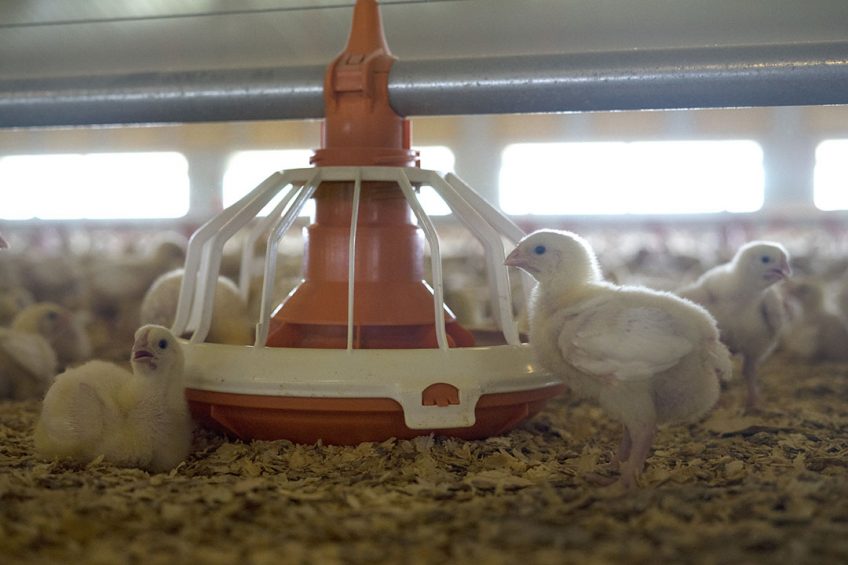Coccidiostats: Antibiotic or feed additive?

The availability and the continuous preventive use of coccidiostats have contributed to a high level of animal health and welfare in poultry production over the past decennia. Sometimes, there is debate over what coccidiostats actually are: feed additives or antibiotics. For the moment, coccidiostats seem to remain on the European Union’s list of feed additives.
The introduction of the first ionophore coccidiostat (monensin) in the 1970’s was an important breakthrough in the fight against coccidiosis. Before that, coccidiosis outbreaks were frequent and the disease was more difficult to treat and to prevent, because only coccidiostats that did not belong to the ionophores were available. They were far less effective because the parasite was able to rapidly build up resistance to them.
Broiler farmers in the European Union make extensive use of these ionophore coccidiostats in poultry feed these days, because they prevent health problems caused by the single-celled Eimeria parasite. At this moment, the European Union classifies ionophore coccidiostats as feed additives. For years, this has been the subject of a recurring intense debate. Some parties think it is better to label coccidiostats as antibiotics, while others think they should remain available as feed additives.
Why the EU wants the feed additive classification for coccidiostats
There is a number of reasons why the European Union chose the coccidiostats’ reclassification as feed additives. Coccidiosis is an endemic disease – the parasite is universally present (oocyst) and is very resistant to environmental conditions. Furthermore, it occurs in all housing systems. A visit to the vet is not necessary to determine the parasite’s presence, which would also add unnecessary costs to the chain. Classification as an antibiotic also means meeting the strict production demands for antibiotics and again, more unnecessary costs. In addition to this, the use of coccidiostats as feed additives guarantees correct dosage, they can be evenly divided through the feed and this prevents over- or under dosage.
What about the development of resistance?
So, what about the development of resistance – the parasite’s resistance against ionophore coccidiostats and resistance in humans? Research into the risks of the use of ionophore coccidiostats, conducted by the Norwegian Scientific Committee for Food Safety, indicates that using coccidiostats can lead to the development of resistance against the ionophore anti-coccidiosis agent and against the antibiotics bacitracine and vancomycine. These are used in human healthcare. The Norwegian researchers do note that their results are based on a limited amount of data and the Norwegian government does not limit their use.
So far no resistance discovered
Ionophore coccidiostats have been used globally for years and up until this moment, a resistance by the parasite against the ionophore coccidiostats has not been discovered. The ionophores’ operating mechanism is unique in that pharmacologically, they completely differ from human and animal antibiotics or only human antibiotics. This means that they do not contribute to antibiotic resistance in humans.
“The safety of ionophore anticoccidials is again emphasised by the fact that they are not on the World Health Organization’s list of medically critical antibiotics or the World Organization for Animal Health’s list of antibiotics they monitor,” says Rolf Poelstra of Elanco Animal Health, one of the biggest producers of ionophore coccidiostats. Ionophore coccidiostats are part of the solution and not part of the problem, Mr Poelstra thinks.
“Preventing coccidiosis is essential for a better gut health and contributes to healthy animals, more animal welfare, a better defence against secondary infections (and because of that; the use of antibiotics) and a good feed conversion. In short: it is essential for sustainable poultry farming, which we very much need to meet the increasing demand for poultry.”

Not standard in Norway or the United States
There are countries in which the use of coccidiostats are no longer standard. This is mostly the case in Norway and United States. In the US, the production of poultry in so-called antibiotic-free chains has increased significantly. Because the US classifies coccidiostats as antibiotics, they are not used in these chains. European broiler farmers do not want measures that would not allow the use of coccidiostats in feed. They point to, among other things, the cost in the US of keeping broilers without coccidiostats. These are not always positive.
‘Ban on coccidiostats does not contribute to a sustainable feed production’Sustainable production does not only mean producing environmentally friendly. Focus on the economy and the welfare of human and animal is also very important, thinks Matthew J Salois. He is chief economist at the American Veterinary Medical Association and conducted research into the sustainability of antibiotic free (AB free) poultry chains in the United States. As far as he is concerned, there is no sustainability. In the US, producing AB free also means not using coccidiostats. These chains now make up almost half of the poultry production in the US. What about animal welfare in AB free chains?“Mortality says a lot about animal welfare in a poultry house. For years, we saw mortality decrease in poultry farming. However, the mortality rate has been slowly increasing since 2013. The cause: AB free chains. In these chains, the average mortality rate is 5.5% by now, against 3-3.5% in regular production. We saw that there are much more health problems in AB free chains. For example: 3.5 times as much deterioration of the broilers’ corneas because of the ammonia in the air, 1.4 times as much sole lesions and 1.5 times as much respiratory problems. These three conditions are not only more prevalent in AB free poultry houses; they are also far more serious.” What about the environmental side?“Because of the prolonged growth period and the less favourable feed conversion, producing poultry in AB free chains is far less efficient. In combination with the higher mortality rate, this means that far more broilers have to be kept to meet the demand for poultry meat. We calculated that 680 to 880 million extra broilers are needed to produce enough meat for American consumers if we produced all poultry in AB free chains. Translate this to extra feed, water and land for these chickens and you will be shocked. Especially if you know that the demand for food will increase sharply in the coming years.” Surely, entrepreneurs that chose to participate in AB free chains must be ok economically?“The economic sustainability is also lacking. Entrepreneurs that produce poultry in an AB free chain do receive a higher selling price for their animals, but they also have to deal with a much higher purchase price. Furthermore, we have seen the price difference between AB free chains and regular chains decrease more and more over the last few years. This has to do with the difficult carcase balance of poultry in AB free chains.” Consumer demand for poultry from an AB free chain is obviously large. Would it not be better to just accept this form of production?“It very much remains the question whether this is truly what consumers want. We find that many consumers are confused. This is corroborated by research. It appears that many consumers think that regular chicken contains antibiotics and hormones. That is why they choose meat with the label AB free. As far as we are concerned, the use of antibiotics for sick animals should not be a part of marketing around poultry meat. It is better to let the consumer choose for animal welfare and sustainability. These are subjects that broiler farmers can actually use.” |
There is a persistent rumour that coccidiostats will be phased out. It is not known where this rumour originates or if it is false. The EU has regulated the use of coccidiostats in regulation No 1831/2003. It does work towards a revision of the regulation, in which the use of feed additives is outlined, as well as the use of coccidiostats.
MEP Annie Schreijer-Pierik (CDA) thinks it is important that broiler farmers in the EU can keep using coccidiostats in feed. When the draft for the European One Health Action Plan against Antimicrobial Resistance (AMR) was written, Ms Schreijer proposed an amendment in September that ensures the availability of agents against certain protozoa, such as coccidia. Ms Schreijer’s amendment was approved by the European Parliament and was incorporated in a resolution for the European Commission.

Ms Schreijer thinks that the unnecessary limitation of coccidiostats may even be counterproductive because broilers that receive no coccidiostats in their feed are ill more often. ”It could unintentionally lead to a higher risk for humans of infection with dangerous bacteria such as salmonella and microbes from food,” she says. She emphasises that she values preventing antibiotic resistance. “We carefully follow the debate on this subject. It is however more important to stimulate antibiotic reduction in the human sector before banning feed additives and with that, increasing food safety risks by a surge in for example salmonella or by more dependence on third countries for, for example, chicken breast.” Ms Schreijer awaits a proposal for a revision of the EU-regulation for feed additives and if necessary, will take action if such a proposal limits the use of coccidiostats.
At this moment, there are no clues that the European Commission plans to take coccidiostats off the list of feed additives. There are parties pleading for this, such as the Federation of Veterinarians of Europe (FVE). This organisation thinks that coccidiostats should no longer be classified as feed additives. According to the FVE, it makes more sense to only allow the use of coccidiostats if the vet prescribes them as an antibiotic. This could help to limit the resistance of Eimeria parasites against certain types of coccidiostats.
In a so-called position paper, the FVE also points out that ionophore coccidiostats may be used in human healthcare in the future, for the control of cancer. Some studies indicate that the anticoccidiosis agent monensin has an inhibiting effect on the spread of kidney cancer cells.
Also read: Dispute over coccidiostats in poultry
Eimeria parasite threatens every broiler flockParasites of the Eimeria type can cause coccidiosis. This parasite is universally present and survives in a form (a so-called oocyst) that is very resistant to environmental factors. Oocysts develop further outside the broiler into infectious stages that can survive in manure for weeks and in soil for months. Coccidiosis is a collective name for several gut infections in poultry that are each caused by a different type of Eimeria (Eimeria acervulina, E. brunetti, E. maxima, E. necatrix and E. tenella). In addition to that, there are two more Eimeria-types (E. mitis and E. praecox) that are often not recognised as a disease, but do cause damage in poultry. Almost all flocks suffer from a form of coccidiosis. Most birds come into contact with different coccidiosis types at a young age and are protected from these types after several weeks, for the rest of their lives. In addition to financial damage as a result of diminished growth and feed conversion, coccidiosis (in combination with Clostridium Perfringens) often causes wet manure and because of that, sole lesions. Each broiler flock experiences coccidiosis, but it does not always make them ill. Broiler farmers need to keep the pressure manageable. In addition to good chick management (take for example feed quality, day-old chicks and climate) and thorough cleaning and disinfection of the poultry house after each round, this usually happens by adding coccidiostats to feed. Eimeria parasites can develop a reduced sensitivity to an anticoccidiosis agent. They can even quite simply develop a full resistance against synthetic coccidiostats. To prevent resistance problems, broiler farmers change agents now and then. |












